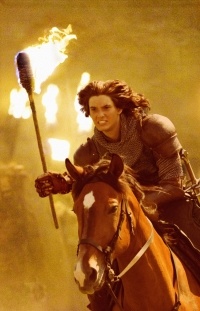c. 2008 Religion News Service
NEW YORK _ C.S. Lewis’ “Chronicles of Narnia” book series is so revered by Christian readers that adapting the books into film becomes a delicate tightrope. Changes risk alienating fans, but what works in the books doesn’t always translate well to the big screen.
On Friday (May 16), Walden Media and Disney will release “The Chronicles of Narnia: Prince Caspian,” the sequel to the wildly successful 2005 film “The Lion, The Witch, and the Wardrobe.” The filmmakers faced the challenge of turning a beloved book with a slow plot into a modern film, but also one that retains the story’s spiritual messages.
“The underlying messages are so important, and so vital to the story,” says Douglas Gresham, Lewis’ stepson and co-producer of the new film.
“Which are the return to faith, truth, justice, honesty, honor, glory, personal commitment, personal responsibility. Also the message (that) no matter how far away we stray, there’s only one way back.”
The first Narnia book, “The Lion, The Witch, and the Wardrobe” told the story of four Pevensie siblings who enter Narnia through an old wardrobe and defeat the tyrannical White Witch. They are aided by the great lion Aslan, but only after he submits himself to be killed in the place of turncoat Edmund Pevensie. The book is widely regarded as a retelling of Lewis’ Christian faith, with Aslan shining as a golden Christ figure who returns after death.
In “Prince Caspian,” the children return to Narnia (this time through a tube station near London’s Trafalgar Square). Although they are only a year older, 1,300 years have passed in their former kingdom. The evil interloper Miraz has stolen the throne from Prince Caspian and forced the true Narnians into hiding.
Aslan has not been seen in centuries. Each character in the movie faces the same crisis: They long to see Aslan but he remains elusive. William Moseley, who plays Peter Pevensie, sees the search for Aslan as a metaphor for faith.
“When you talk about seeing, I think it’s more believing,” he said. “You believe, and then you see. Aslan represents God. People say, `If God’s there, why can’t I see him?’ Well, because you’re not believing.”
The movie format necessitated some changes to the book’s storyline.
“Essentially, the book is a long walk followed by a short battle,” says Andrew Adamson, the film’s director and producer. He rearranged the time line to put more action at the beginning and expanded the battle scene.
He also had to leave out some beloved scenes and characters. Goodbye to Greek God Bacchus and his wild girls who in the book accompany Aslan on a joyful romp; writer Stephen McFeely said the Greek gods are no longer an easily recognizable cultural reference. Other characters were squeezed out by time constraints; Lewis’ deftly drawn characters of talking bears, squirrels and dogs fade to the background.
However, such sacrifices allow more room to fully explore such characters as Reepicheep the valiant mouse, and Trufflehunter the faithful badger, both developed using computer-generated imagery. The film version also delves more deeply into the heart of Peter. His inability to see Aslan when his sister Lucy does _ a key part of the book _ is expanded into an inner struggle between his trust in Aslan and an ego-driven desire to prove himself.
Caspian, played by Ben Barnes, has a similar struggle: his desire for revenge against his evil uncle Miraz (Sergio Castellitto) nearly overwhelms his desire to serve Aslan purely in the cause of freedom.
Adamson also updated the movie for 21st century mores. To make it more inclusive, he added female dwarves, child-aged fawns and an “Afro-centaur” (Cornell John) as Glenstorm, the noble half-man, half-horse. In addition, the Pevensie sisters, Susan (Anna Popplewell) and Lucy (Georgie Henley), join the battle, which they avoid in the book.
For Adamson, it was an obvious choice to allow women an active role in the fight. Referring to the gift of bow and arrow that Susan received in the first movie, Adamson laughs, “If she’s just going to make sandwiches, then give her a plate and a knife.”
(BEGIN OPTIONAL TRIM)
Adamson made his case for the changes to Gresham by arguing that Lewis’ female characters become stronger as the book series progresses _ something he attributes to Lewis’ real-life romance with Gresham’s mother, Joy Davidman.
Gresham agreed. As evidence, he recounted an encounter he witnessed between Lewis, Davidman and a longbow-wielding trespasser on their property. Davidman carried a small “garden gun.” When the man aimed a drawn arrow at the pair, Lewis chivalrously stepped in front of Davidman to shield her. He remained for a moment until Davidman, a Bronx native, commanded, “Goddamn, Jack, get out of my line of fire.”
“That whole kind of experience of my mother’s determination and personality I think changed Jack’s ideas towards women,” says Gresham.
(END OPTIONAL TRIM)
This is the last of Narnia for Moseley and Popplewell, whose characters do not return in later books (“The Voyage of the `Dawn Treader”’ is the next in the series). “I was sad about that,” says Popplewell, “but I’m excited to do new things.”
Still, they’ve taken home some lessons from their time in Narnia. “Peter learned leadership is about serving other people,” Moseley said, “and not serving yourself. Peter had to learn to reinstate his trust in Aslan.”
KRE/PH END CUSEY





